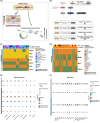Cell-type-specific gene expression and regulation in the cerebral cortex and kidney of atypical Setbp1S858R Schinzel Giedion Syndrome mice
- PMID: 37872881
- PMCID: PMC10660642
- DOI: 10.1111/jcmm.18001
Cell-type-specific gene expression and regulation in the cerebral cortex and kidney of atypical Setbp1S858R Schinzel Giedion Syndrome mice
Abstract
Schinzel Giedion Syndrome (SGS) is an ultra-rare autosomal dominant Mendelian disease presenting with abnormalities spanning multiple organ systems. The most notable phenotypes involve severe developmental delay, progressive brain atrophy, and drug-resistant seizures. SGS is caused by spontaneous variants in SETBP1, which encodes for the epigenetic hub SETBP1 transcription factor (TF). SETBP1 variants causing classical SGS cluster at the degron, disrupting SETBP1 protein degradation and resulting in toxic accumulation, while those located outside cause milder atypical SGS. Due to the multisystem phenotype, we evaluated gene expression and regulatory programs altered in atypical SGS by snRNA-seq of the cerebral cortex and kidney of Setbp1S858R heterozygous mice (corresponds to the human likely pathogenic SETBP1S867R variant) compared to matched wild-type mice by constructing cell-type-specific regulatory networks. Setbp1 was differentially expressed in excitatory neurons, but known SETBP1 targets were differentially expressed and regulated in many cell types. Our findings suggest molecular drivers underlying neurodevelopmental phenotypes in classical SGS also drive atypical SGS, persist after birth, and are present in the kidney. Our results indicate SETBP1's role as an epigenetic hub leads to cell-type-specific differences in TF activity, gene targeting, and regulatory rewiring. This research provides a framework for investigating cell-type-specific variant impact on gene expression and regulation.
Keywords: SETBP1; Schinzel Giedion Syndrome; gene regulatory networks; genomics; rare disease; single-cell.
© 2023 The Authors. Journal of Cellular and Molecular Medicine published by Foundation for Cellular and Molecular Medicine and John Wiley & Sons Ltd.
Conflict of interest statement
The authors have declared no conflicts of interest.
Figures






References
-
- Schinzel A, Giedion A. A syndrome of severe midface retraction, multiple skull anomalies, clubfeet, and cardiac and renal malformations in sibs. Am J Med Genet. 1978;1:361‐375. - PubMed
-
- Schinzel Giedion Syndrome—NORD (National Organization for Rare Disorders). 2015.
-
- Liu W‐L, He Z‐X, Li F, Ai R, Ma HW. Schinzel–Giedion syndrome: a novel case, review and revised diagnostic criteria. J Genet. 2018;97:35‐46. - PubMed
Publication types
MeSH terms
Supplementary concepts
Grants and funding
LinkOut - more resources
Full Text Sources
Molecular Biology Databases
Research Materials
Miscellaneous

